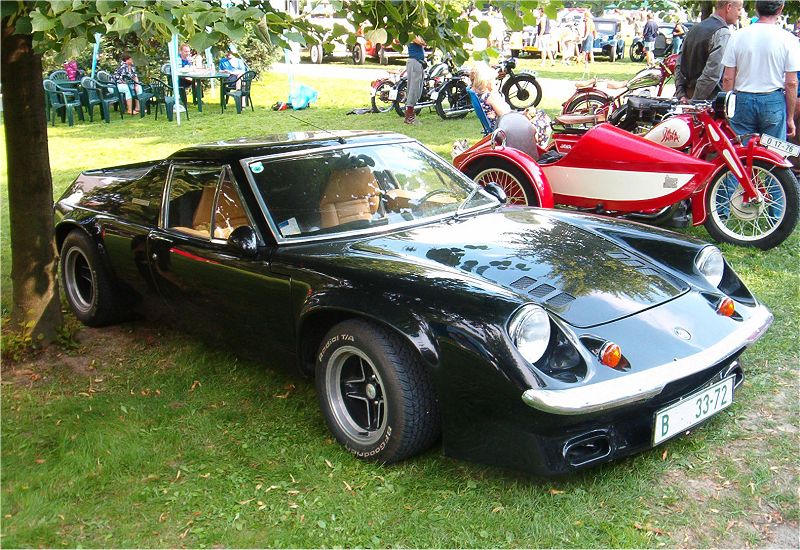Description
The Lotus Europa Special was the ultimate expression of the Europa line—a refined, more powerful, and beautifully finished version of Colin Chapman’s mid-engine masterpiece. Introduced in 1972, the Special was the final and most developed iteration of the Europa, combining the agility and lightness that had defined the model with a level of power, performance, and sophistication that brought it into true sports car territory. It was a car that bridged Lotus’s pure racing heritage and its emerging identity as a builder of refined, high-performance grand tourers.
By the early 1970s, the Europa had already earned a reputation for exceptional handling and aerodynamics. Its mid-engine layout, derived directly from Lotus’s Formula One experience, gave it balance and stability that few road cars could match. The Special took that foundation and added the most potent engine yet fitted to a production Europa: the 1,558 cc Lotus Twin Cam “Big Valve” engine. This version of the famed four-cylinder unit—based on Ford’s Kent block and topped with a Lotus-designed aluminum twin overhead camshaft head—produced 126 horsepower at 6,500 rpm and 113 lb-ft of torque.
Mated to a five-speed gearbox sourced from Renault, the new engine transformed the Europa into a genuinely fast sports car. The Special could accelerate from 0 to 60 mph in just 6.6 seconds and reach a top speed of around 125 mph. While those numbers were impressive for the early 1970s, it was the way the car delivered its performance that made it so special. The Twin Cam engine was eager and free-revving, pulling cleanly from low revs before surging toward its redline with a distinctive, mechanical urgency. The Europa’s light weight—barely 740 kilograms—meant it didn’t need vast power to feel thrilling; every movement of the throttle translated directly into acceleration and response.
The chassis and suspension remained largely unchanged from the earlier Europa Twin Cam, and that was no bad thing. The backbone chassis design, combined with fully independent suspension—double wishbones at the front and Lotus’s own multi-link setup at the rear—gave the car its legendary composure and precision. Steering was unassisted but quick and extraordinarily communicative. The car felt alive in the driver’s hands, with every bump and camber shift transmitted directly through the thin-rimmed wheel. Few cars before or since have delivered such clear, nuanced feedback.
The Europa’s handling balance was its defining trait. The mid-engine layout placed the mass close to the center of the car, giving it near-perfect weight distribution. Through corners, the Europa turned in with sharp precision, its light front end responding instantly while the rear stayed planted and stable. Drivers could adjust the car’s attitude mid-corner with minute throttle changes, and once familiar with its balance, the car felt effortless to control at the limit. It had the agility of a race car, but without the nervousness—Chapman’s genius for suspension tuning made sure of that.
Visually, the Europa Special stood apart from earlier models with a more luxurious and dramatic appearance. The body retained its distinctive low-slung, aerodynamic shape but featured new detailing, including polished alloy wheels, brightwork trim, and special badging. The most famous version came finished in black with gold striping—a nod to the John Player Special Formula One livery that adorned Lotus’s championship-winning cars driven by Emerson Fittipaldi. Other colors were offered, but none captured the era’s glamour and racing heritage as vividly as the black-and-gold combination.
Inside, the Special represented a significant step forward in refinement. The cabin was trimmed in higher-quality materials, with thick carpeting, wood veneer on the dashboard, and full instrumentation. The driving position remained low and reclined, typical of a mid-engine sports car, with excellent visibility over the flat bonnet and fenders. The controls were perfectly placed, the gear lever short and precise, and the pedals ideally spaced for heel-and-toe driving. Despite the added luxury, the Europa still felt intimate and purposeful—every detail centered on the experience of driving.
In motion, the Europa Special offered one of the most immersive and rewarding driving experiences of its time. The engine’s sound, a crisp and mechanical rasp, filled the small cabin as revs climbed. The car’s lightness made it feel faster than its numbers suggested; acceleration was immediate, cornering effortless, and the sense of connection total. At speed, the low drag and stable aerodynamics made the car feel secure and planted, characteristics that set it apart from the more muscular but heavier sports cars of the era.
The Europa Special also reflected Chapman’s growing ambition to blend performance with sophistication. While the earlier Europas had been brilliant but austere, the Special was a car that could appeal to a broader audience—still uncompromising in handling, but far more polished in execution. It was the first Europa that truly combined Lotus’s race-bred engineering with an element of grand touring comfort.
Production of the Europa Special lasted until 1975, by which time Lotus had shifted focus to the upcoming Esprit. Around 3,130 examples of the Special were built, making it one of the more numerous Europa variants, yet each carried an unmistakable air of rarity and significance as the final evolution of a groundbreaking design.
Today, the Lotus Europa Special is regarded as one of the purest and most rewarding mid-engine sports cars ever produced. It remains a masterpiece of minimalist engineering—a car that achieves brilliance not through power or technology, but through intelligence, balance, and lightness. Driving one is an experience defined by clarity: every sound, vibration, and movement connects the driver to the road in a way few cars ever have.
The Lotus Europa Special was, in many ways, the perfect conclusion to Chapman’s original vision. It took the lessons of Lotus’s racing triumphs and distilled them into a car that ordinary drivers could enjoy every day. Light, fast, elegant, and endlessly engaging, it stood as a celebration of everything that made Lotus unique—and a fitting farewell to one of the most innovative sports cars of its era.
